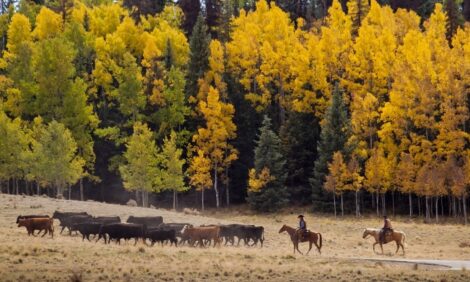



Supplement Your Feed to Avoid Grass Tetany
US - As pastures start to green up in the eastern Corn Belt, cattle producers need to be aware of the risk of grass tetany in grazing animals, a Purdue Extension beef specialist says.Grass tetany, or grass staggers, is a nutritional disease that cattle get from grasses high in water content and potassium and low in other nutrients, such as magnesium and calcium. Older cows that have just calved and are in peak lactation are the most susceptible.
The risk increases in pastures that have been heavily fertilized with nitrogen, so those producers who have spread fertilizers such as poultry litter, hog manure or urea are more at risk.
While the condition is treatable if caught early enough, Ron Lemenager said it's best to prevent it altogether.
"The easiest way to prevent grass tetany is to start these cows on a high magnesium mineral prior to going to grass in the spring," he said. "That mineral mix should have a minimum of 8 per cent magnesium, and it could be 12 per cent or higher."
The problem with a high magnesium supplement is that the source is typically magnesium oxide, which isn't something cattle like to eat.
"What we'll see is that a lot of commercial mineral mixes containing magnesium will include a palatability enhancer - something like dried distillers grains, soybean hulls, wheat midds or dried molasses - to help encourage consumption," Lemenager said. "We're looking at, typically, 4 ounces of mineral consumption to get adequate levels of magnesium when it's included in the supplement at 8 to 12 per cent."
The peak season for grass tetany is April through early May, so now is the time to keep an eye on grazing animals. If a cow is stricken with grass tetany, the cattle producer doesn't have long to respond. Often, cows will die within 2-3 hours of the first symptoms.
Those symptoms include stumbling and staggering, trembling muscles, muscle twitches, excitability, stiff gait, grinding teeth and eventually violent convulsions, coma and death.
"The treatment is an IV administration of magnesium and dextrose, which is probably going to require veterinarian intervention," Lemenager said. "So if you see one of those cows that's acting a little funny, it's probably time to call the vet and get this cow treated. If you wait, the next time you see that cow, she'll probably be dead."
More information about grass tetany, including prevention, symptoms and treatment, is available in Lemenager's video, "Grass Tetany: A Primer," which can be found at http://www.thebeefcenter.com by clicking the video link in the left column.
TheCattleSite News Desk

